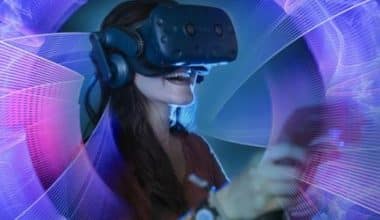Over the past decade, virtual reality company setups (VR) have advanced significantly and found a place in several industries due to a recent boom in VR businesses. By 2030, the VR and AR market is anticipated to reach $454 billion and 23 million. But while virtual reality (VR) is still mostly considered a gaming technology, it has also been shown to be an effective tool for non-gaming entertainment, e-commerce, employee development, and medical training. So relax as we list the top biggest virtual reality companies you need to know in this article.
What is a Virtual Reality Company
Entertainment (especially video games), and education (such as medical or military training). And business (such as virtual meetings) are just a few examples of applications for virtual reality. Aside from virtual reality, other forms of technology include augmented reality and mixed reality, sometimes known as extended reality or XR. However, definitions are still evolving as the field develops.
What is a Virtual Reality Company All About
Virtual reality companies help to provide realistic pictures, sounds, and other sensations. This also imitates a user’s physical presence in a virtual environment. Current standard virtual reality systems either use virtual reality headsets or multi-projected environments. A user can see around the virtual world, move around in it, and interact with virtual features or objects while utilizing virtual reality technology.
The impression can also be produced by specially built rooms with large screens. Although VR headsets most frequently produce it with a head-mounted display with a small screen in front of the eyes. Virtual reality normally includes audio and visual feedback. But haptic technology may also enable additional types of sensory and force feedback.
Challenges of Virtual Reality Company
Safety and Health
Virtual reality has a lot of health and safety issues. Consumer alerts for most virtual reality systems include information on seizures, child developmental concerns, trip-and-fall and collision risks, discomfort, repetitive stress injury, and interference with medical devices. Even if they have no history of epilepsy and have never experienced seizures or blackouts, some users of VR headsets may experience cramps, seizures, or blackouts while using them.
These symptoms could occur in.025%, or one in every 4,000 persons. The most common short-term negative effects are motion sickness, eyestrain, headaches, and discomfort. Additionally, youngsters may experience discomfort more frequently due to the bulky weight of virtual reality headsets. Therefore, kids shouldn’t use VR headsets. Physical interactions with one’s environment may lead to other issues. People who wear VR headsets quickly become unaware of their surroundings and risk tripping over or colliding with real-world things.
Best Virtual Reality Company
Here is the list of the best virtual reality company to think about:
#1. Apple
- Location: Cupertino, California
Apple Vision Pro users may use the headset like a pair of goggles to navigate apps, examine photos, and watch movies in any setting. It is notable for including Apple’s first 3D camera and vision, the company’s first spatial operating system. However, the firm does not specifically refer to the product as using VR or AR.
#2. Matterport
- Location: Sunnyvale, California
How it advances VR, anyone who has ever looked for a home knows that, especially when moving a great distance, there is a long time between finding preliminary information about a potential home and setting foot inside. As a result, 3D imaging tours for residential real estate have taken off. The method used by Matterport uses computer vision to “read” intricate layouts.
#3. Qualcomm
- Location: San Diego, California
Qualcomm is well-known for its work with semiconductors, 5G, and wireless technologies. But it also intends to have an impact on how we perceive VR. This is how it is revolutionizing VR. The business wants to develop fully portable, immersive mobile VR that customers can take wherever they g with hardware-accelerated composition, 3D overlays, and support for graphics APIs, including OpenGL, OpenCL, and Vulkan. And a choice of display options, the Qualcomm Snapdragon XR1 is an improved extended reality headset and platform.
#4. Microsoft
- Location: Redmond, Virginia
How it is advancing VRMicrosoft unveiled its Mixed Reality product range in 2017. The company sells PCs that can work with VR technology and VR headsets and controls. The HoloLens 2 has a variety of enterprise applications and employs holograms to direct users through tasks. Microsoft Azure also allows for the creation of unique applications by users.
#5. Unity
- Location: California, San Francisco
How Unity is inventing VR: With VR, Unity has gained traction with industries other than the conventional gaming sector. For example, it has established relationships with automakers who use its virtual reality imagery as a prototyping tool and filmmakers who use it to juggle many production jobs. Nevertheless, it continues to be a gaming powerhouse, with its development engine allegedly providing the foundation for half of all mobile games and more than half of all virtual or augmented reality content, including Pokémon Go. One of its noteworthy VR experiences is Coco VR, Pixar’s first solo virtual reality film produced in partnership with Magnopus.
#6. Meta
- Location: Menlo Park, California
How it advances VRAny conversation about virtual reality (VR) must start with Met, well-known for purchasing Oculus for $2 billion in 2014, sparking the second major inferno of VR enthusiasm. In 2016, often known as the “Year of Virtual Reality,” introduced the Oculus Rift hea and with the HTC Vive, and PlayStation VR. Since then, scores of VR games and apps have become available thanks to Meta’s Quest headset series.
#7. Applied VR
- Location: Van Nuys, California
Applied VRR was established due to 30 years of academic investigation into the most efficient ways to integrate virtual reality into the medical field. Users of the VR platform can avoid, process, and treat chronic pain via immersive medicines. According to the company’s website, more than 200 institutions and 60,000 patients have used the ground-breaking technology.
#8. Wevr
- Location: Los Angeles, California
Wevr Virtual Studio is a game and interactive film production tool that creators can store, build, and edit their VR projects on a single platform. This is how it is reinventing VR. Wevr has been releasing projects with artists like Reggie Watts, Run the Jewels, and Deepak Chopra for over ten years. To make a virtual reality movie, the business also collaborated with tech-obsessed blockbuster director Jon Favreau.
#9. Transfr
- Location: New York, New York
VRTransfr is an educational technology business that trains professionals in critical skills using virtual reality. Students practice their jobs in virtual environments, including warehouses, airfields, and construction sites, while receiving instructor feedback while donning VR headsets and holding handheld controllers. After completing the VR-based instruction, students are prepared to take real-world lessons from instructors.
#10. Vicarious Surgical
- Location: Waltham, Massachusetts
Vicarious Surgical is redefining surgical technology and skills for patients with abdominal surgeries to offer better outcomes and less risk or invasiveness. The system consists of two parts: the surgeon console, which controls the robot and may be operated via a 3D screen, a VR headset, and the system’s proprietary software, and the patient cart, which has two robotic arms with extraordinary reach, movement, and visibility. The Vicarious surgical system, which is still in development, is anticipated to feature 28 sensors per arm and only needs a 1.2cm incision.
Virtual Reality Stocks
The sector is expected to generate $87 billion in total revenue by 2030, with a total market value of $21.8 billion in 2021. Beyond entertainment and gaming, Grand View Research’s analysis states that the technology’s “instructional training, such as for teaching engineers, mechanics, pilots, field workers, defence warriors, and technicians in the manufacturing and oil and gas sectors, is propelling the market growth.” Even event organizers are using VR.
#1. (QCOM) Qualcomm Inc.
Because of its emphasis on smartphones, Qualcomm is another virtual reality stock to keep an eye on if Zuckerberg is correct that most people will initially encounter the metaverse through their phones. Smartphones, laptops, tablets, and smartwatches running Android and Windows all employ Qualcomm Snapdragon processors. Even Meta’s Oculus Quest 2 employs it. Given that shares of QCOM have been trading more or less sideways over the past year, if you believe that VR will be mostly used on mobile devices rather than personal computers, QCOM may be the stock selection for you.
#2. AAPL Apple Inc.
The Vision Pro, an augmented reality headset, was launched by Apple in early June. This is the company’s first product category since the Apple Watch was introduced nine years ago. The ski-goggle-like headset is described as a “spatial computer” because it lets users superimpose virtual images, videos, and apps over real-world surfaces. The wearer can interact with what they view thanks to eye and hand tracking pinching the air can zoom in or out of a picture. The $3,499 price tag for the Vision Pro is one of the major unanswered questions surrounding its introduction. Quest 2 will be a challenging set, which costs between $ will be challenging299 and $499 per unit.
#3. Meta Platforms Inc. (META)
of virtual reality (discussion VR) should begin with Meta Platforms Inc., previously Facebook. CEO Mark Zuckerberg stated that the company’s objectives are still AI and the metaverse in the fourth quarter of 2022 earnings presentation, referring to these as the “two major technical waves driving our roadmap” both now and in the long run. While Meta continued to invest in virtual reality and reported a nearly $4 billion operating loss in the first quarter, up from a nearly $3 billion operating loss in Q1 2022, it spent more time discussing artificial intelligence than the metaverse in its Q1 2023 financial release.
Leading Virtual Reality Company
Most large tech corporations have also invested significantly in the top virtual reality start-ups or the greatest virtual reality enterprises.
#1. Microsoft
Microsoft is well known for its computers, IoT, and networking efforts. Still, it is now recognized for its augmented reality (AR) initiatives, including the Windows HoloLens and Windows Holographic development platform. It is among the largest VR businesses in the world right now.
- Established in 1975
- Employees: 100,000-144,000
- Locations: Asia, Europe, Africa, and all over the world, as well as Washington, USA, and many other US locations, including California, Alabama, Florida, and New York.
- $143.02 billion in revenue
- Core Services: PCs equipped for mixed reality, like the HP Pavilion Power Desktop, and add-ons utilizing the HoloLens headgear and Windows Holographic platform. The PCs have strong NVIDIA graphics that can support software and hardware for VR, AR, and MR experiences, as well as various connectors, including HDMI and display ports that let users connect multiple VR devices at once and share VR experiences.
#2. Next/Now
A design agency called Next/Now specializes in creating apps, animations, animations for fairs and festivals, and experiences for virtual reality and augmented reality. Its members include brand strategists, computer scientists, game developers, display experts, 3D experts, animators, designers, and producers.
It specializes in multi-touch surfaces, including holographic, 3D animations, motion, gesture digital experiences, and projection mapping to transform physical places into virtual 3D surfaces. It also discusses VR and AR experiences.
- The business is headquartered on Chicago’s Lake Street and was established in 2011.
- Established in 2011
- Employees: 65-74
- Locations: Chicago
- Bringing in $9.3 million
- Core Services: The Cummins AR car tour, the LG AR product visualization, the John Deere project mapping experience, and the McDonald’s virtual pit crew challenge based on AR are some of the top VR and AR branding experiences.
#3. Unity (USA, San Francisco)
Unity is well-known for being a game engine that lets users create games and gaming-related elements. Even among the top VR firms, it is most likely the company with the largest and most relationshiThe majority of VR and 3D content has adopted the Unity platform tent.
Now that their game engine is VR-ready, users may create 3D and VR content for various headsets.
Most smartphone games and virtual or augmented reality material, including Pokemon Go, are built using the Unity programming engine.
- Established in 2004
- Employees: 3000-3379
- Twenty-two offices spread over 12 nations, including those in San Francisco, Austin, Bellevue, China, Berlin in Germany, Kaunas in Lithuania, Chuo in Japan, Singapore, Sweden, Korea, and Brighton in the UK.
- $541.8 million in revenue
- Core Services: The Unity game creation platform supports VR devices and content forms. One of the best VR standouts is Coco VR.
VR firms employ Unity virtual reality imaging as a prototyping tool. It can be used as a variety of production tools by VR filmmakers.
Virtual Reality Company to Invest in
Here is a look at each of these stocks related to virtual reality.
#1. Apple
The Vision Pro was revealed by Apple on June 5 at its Worldwide Developers Conference. Since the release of the Apple Watch in 2016, the firm has not introduced a new product category before the headset.
The Vision Pro has advanced VR significantly with features not found in competitor headsets up to this point. The gadget has all the productivity and entertainment features of a MacBook because it is an entire computer housed in a headset. Meanwhile, it has done away with the requirement for controls in Sony and Meta headsets by using eye tracking and hand gestures.
#2. Advanced Micro Devices
Using the same CPU as the current MacBook Air, Apple’s Vision Pro has raised the bar for virtual reality. In contrast, Qualcomm’s Snapdragon XR2 CPU, based on the Snapdragon 865 used in premium smartphones in 2020, is featured in Meta’s Oculus Quest Pro headset.
As a result, Apple has effectively turned its headset into a full-fledged computer, but its main rival’s equivalent device only has the processing capability of a smartphone three years old. The disparity will probably spur businesses to improve since Apple has raised the bar for the sector.
Who is the Leader in AR and VR?
Google is the AR and VR leader. The Daydream VR headset and Google Cardboard are only two of the VR and augmented reality technologies that Google has created. In addition, Google has created ARCore, an Android framework for building augmented reality apps.
Is Virtual Reality a Good Business?
The ability to give workers, stakeholders, and collaborators an immersive view of a real-world environment in real-time may be the most evident value of VR experiences for businesses. Both productivity and safety measures may benefit from this.
How Much Does a VR Cost?
In the United States, the average cost of a virtual reality (VR) headset was 430 dollars in 2022, and this cost is forecast to hold steady over the coming years. A few well-known manufacturers of VR headsets are Meta (formerly Oculus), Pico, Sony, HTC, and Valve.
What are the 3 Types of Virtual Reality?
Virtual reality simulations fall into three main categories:
- Non-immersive
- Semi-immersive
- Fully-immersive.
What Company owns Oculus?
In 2014, Facebook paid $2 billion for Oculus as part of its incredibly costly and almost ten-year-long quest for its virtual reality cosmos. Luckey now oversees the security and military product business of Anduril Industries after being sacked from Facebook in 2016.
What Exactly is a Metaverse?
Here is a task to show you how ambiguous the word “the metaverse” might be: In a sentence, mentally change “the metaverse” to “cyberspace.” 90% of the time, the meaning won’t be much altered. This is due to the fact that the phrase doesn’t truly apply to a single form of technology but rather to a wide (and frequently hypothetical) change in how humans engage with technology.
Conclusion
All VR systems must maintain ongoing tracking, which makes the technology particularly suited for mass surveillance and exposure to it. The potential for information gathering about individual activities, movements, and responses will expand with the development of VR while prices will decrease. A user’s ethnicity, personality traits, fears, emotions, hobbies, talents, and physical and mental health concerns may be inferred from data collected by eye-tracking sensors, which are anticipated to become a standard feature in virtual reality headsets.
Related Articles
- Affiliate Marketing Products: Best 9+ Picks for 2023
- HOW DOES FACEBOOK MAKE MONEY IN 2023
- TOP BUSINESS TRENDS TO LOOK OUT FOR IN 2023-2024
- How Digital Health Technology is Transforming Healthcare
- Meta Business Suite: Everything You Should Know






